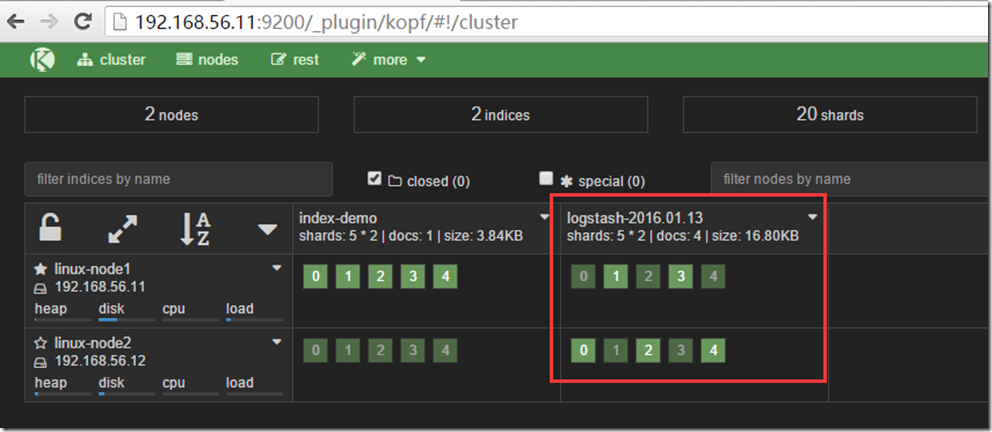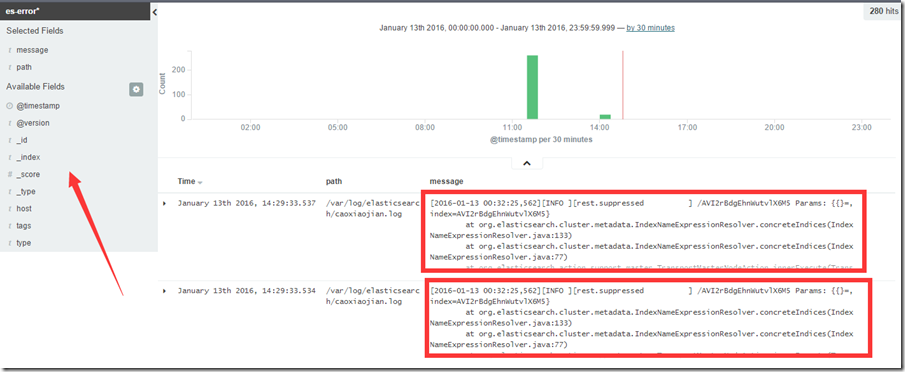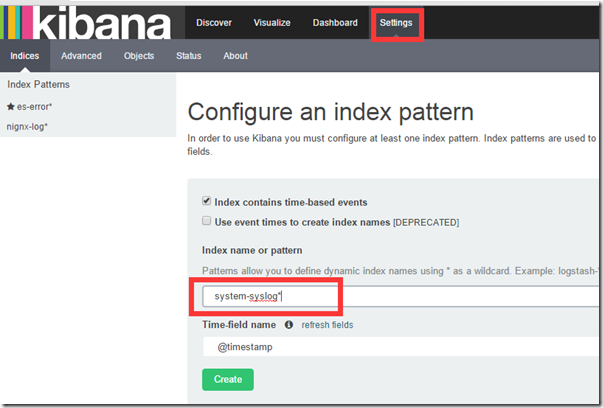概念介绍
Elasticsearch
ElasticSearch是一个基于Lucene的搜索服务器。它提供了一个分布式多用户能力的全文搜索引擎,基于RESTful web接口。Elasticsearch是用Java开发的,并作为Apache许可条款下的开放源码发布,是第二流行的企业搜索引擎。设计用于云计算中,能够达到实时搜索,稳定,可靠,快速,安装使用方便。
在elasticsearch中,所有节点的数据是均等的。
Logstash
Logstash是一个完全开源的工具,他可以对你的日志进行收集、分析,并将其存储供以后使用(如,搜索),您可以使用它。说到搜索,logstash带有一个web界面,搜索和展示所有日志。
Kibana
Kibana是一个基于浏览器页面的Elasticsearch前端展示工具。Kibana全部使用HTML语言和Javascript编写的。
elastic的部署配置文档
https://www.elastic.co/guide/index.html
部署环境
系统: Centos7.1
防火墙: 关闭
Sellinux: 关闭
主机名: 配置规范
主机: 两台
注明: 两台主机同时操作,安装一下软件。
(一)Elasticsearch
基础环境安装
1:下载并安装GPG Key
[root@hadoop-node1 ~]# rpm --import https://packages.elastic.co/GPG-KEY-elasticsearch
2:添加yum仓库
[root@hadoop-node1 ~]# vim /etc/yum.repos.d/elasticsearch.repo [elasticsearch-2.x] name=Elasticsearch repository for 2.x packages baseurl=http://packages.elastic.co/elasticsearch/2.x/centos gpgcheck=1 gpgkey=http://packages.elastic.co/GPG-KEY-elasticsearch enabled=1
3:安装elasticsearch
[root@hadoop-node1 ~]# yum install -y elasticsearch
4:安装相关测试软件
#安装Redis yum install -y redis #安装Nginx yum install -y nginx #安装java yum install -y java
5:安装完java后,检测
[root@linux-node1 src]# java -version openjdk version "1.8.0_65" OpenJDK Runtime Environment (build 1.8.0_65-b17) OpenJDK 64-Bit Server VM (build 25.65-b01, mixed mode)
配置部署
1:配置修改配置文件
[root@linux-node1 ~]# mkdir -p /data/es-data [root@linux-node1 src]# vim /etc/elasticsearch/elasticsearch.yml cluster.name: caoxiaojian # 组名(同一个组,组名必须一致) node.name: linux-node1 # 节点名称,建议和主机名一致 path.data: /data/es-data # 数据存放的路径 path.logs: /var/log/elasticsearch/ # 日志存放的路径 bootstrap.mlockall: true # 锁住内存,不被使用到交换分区去 network.host: 0.0.0.0 # 网络设置 http.port: 9200 # 端口
2:启动并查看
[root@linux-node1 src]# chown -R elasticsearch.elasticsearch /data/ [root@linux-node1 src]# systemctl start elasticsearch [root@linux-node1 src]# systemctl status elasticsearch CGroup: /system.slice/elasticsearch.service └─3005 /bin/java -Xms256m -Xmx1g -Djava.awt.headless=true -XX:+UseParNewGC -XX:+UseConcMarkSweepGC -XX:CMSI... ##### 内存最小256m,最大1g [root@linux-node1 src]# netstat -antlp |egrep "9200|9300" tcp6 0 0 :::9200 :::* LISTEN 3005/java tcp6 0 0 :::9300 :::* LISTEN 3005/java
然后通过web访问(我的IP是192.168.56.11)
3:通过命令的方式查看数据
[root@linux-node1 src]# curl -i -XGET 'http://192.168.56.11:9200/_count?pretty' -d '{"query":{"match_all":{}}}' HTTP/1.1 200 OK Content-Type: application/json; charset=UTF-8 Content-Length: 95 { "count" : 0, "_shards" : { "total" : 0, "successful" : 0, "failed" : 0 } }
有没有觉得特别的不爽,要用命令来查看。
4:上大招,使用head插件来查看
4.1:安装head插件
[root@linux-node1 src]# /usr/share/elasticsearch/bin/plugin install mobz/elasticsearch-head
4.2:使用head插件后,使用web插件
###插入数据实例:
###查看数据实例
###复合查询实例
5:监控节点
5.1安装
[root@linux-node1 src]# /usr/share/elasticsearch/bin/plugin install lmenezes/elasticsearch-kopf
5.2查看
http://192.168.56.11:9200/_plugin/kopf/#!/cluster
下面进行节点2的配置
注释:其实两个的安装配置基本上是一样的,不同的地方我会红色标记。
# 配置文件的修改 [root@linux-node2 src]# mkdir -p /data/es-data [root@linux-node2 src]# vim /etc/elasticsearch/elasticsearch.yml [root@linux-node2 src]# grep "^[a-z]" /etc/elasticsearch/elasticsearch.yml -n 17:cluster.name: caoxiaojian 23:node.name: linux-node2 33:path.data: /data/es-data 37:path.logs: /var/log/elasticsearch 43:bootstrap.mlockall: true 54:network.host: 0.0.0.0 58:http.port: 9200 79:discovery.zen.ping.multicast.enabled: false 80:discovery.zen.ping.unicast.hosts: ["192.168.56.11", "192.168.56.12"] # 修改权限配置 [root@linux-node2 src]# chown -R elasticsearch.elasticsearch /data/ # 启动服务 [root@linux-node2 src]# systemctl start elasticsearch [root@linux-node2 src]# systemctl status elasticsearch ● elasticsearch.service - Elasticsearch Loaded: loaded (/usr/lib/systemd/system/elasticsearch.service; disabled; vendor preset: disabled) Active: active (running) since Wed 2016-01-13 00:42:19 CST; 5s ago Docs: http://www.elastic.co Process: 2926 ExecStartPre=/usr/share/elasticsearch/bin/elasticsearch-systemd-pre-exec (code=exited, status=0/SUCCESS) Main PID: 2928 (java) CGroup: /system.slice/elasticsearch.service └─2928 /bin/java -Xms256m -Xmx1g -Djava.awt.headless=true -XX:+UseParNewGC -XX:+UseConcMarkSweepGC -XX:CMSI... Jan 13 00:42:19 linux-node2.example.com systemd[1]: Starting Elasticsearch... Jan 13 00:42:19 linux-node2.example.com systemd[1]: Started Elasticsearch. # 查看端口 [root@linux-node2 src]# netstat -antlp|egrep "9200|9300" tcp6 0 0 :::9200 :::* LISTEN 2928/java tcp6 0 0 :::9300 :::* LISTEN 2928/java tcp6 0 0 127.0.0.1:48200 127.0.0.1:9300 TIME_WAIT - tcp6 0 0 ::1:41892 ::1:9300 TIME_WAIT -
添加了node2后,咱们再来看head页面
原本只有linuxnode1节点,现在出现了node2。星号表示主节点。
在ELK中,它的主从节点没有特殊的地方,他们的数据是相同的。
(二)Logstash
基础环境安装
1:下载并安装GPG Key
[root@hadoop-node1 ~]# rpm --import https://packages.elastic.co/GPG-KEY-elasticsearch
2:添加yum仓库
[root@hadoop-node1 ~]# vim /etc/yum.repos.d/logstash.repo [logstash-2.1] name=Logstash repository for 2.1.x packages baseurl=http://packages.elastic.co/logstash/2.1/centos gpgcheck=1 gpgkey=http://packages.elastic.co/GPG-KEY-elasticsearch enabled=1
3:安装logstash
[root@hadoop-node1 ~]# yum install -y logstash
4:logstash启动
[root@linux-node1 src]# systemctl start elasticsearch
数据的测试
1:基本的输入输出
[root@linux-node1 src]# /opt/logstash/bin/logstash -e 'input { stdin{} } output { stdout{} }' Settings: Default filter workers: 1 Logstash startup completed hello # 输入hello 2016-01-13T01:40:45.293Z linux-node1.example.com hello # 输出这个
2:使用rubydebug详细输出
[root@linux-node1 src]# /opt/logstash/bin/logstash -e 'input { stdin{} } output { stdout{ codec => rubydebug} }' Settings: Default filter workers: 1 Logstash startup completed hello # 输入 hello { "message" => "hello", # 输入的信息 "@version" => "1", # 版本 "@timestamp" => "2016-01-13T01:43:19.454Z", # 时间 "host" => "linux-node1.example.com" # 存放在哪个节点 }
3:把内容写到elasticsearch中
[root@linux-node1 src]# /opt/logstash/bin/logstash -e 'input { stdin{} } output { elasticsearch { hosts => ["192.168.56.11:9200"]} }' Settings: Default filter workers: 1 Logstash startup completed # 输入一下数据测试 123123 hehehehe 123he123he qwert
使用rubydebug和写到elasticsearch中的区别:其实就是后面标准输出的区别。一个使用codec;一个使用elasticsearch
写到elasticsearch中在logstash中查看
4:即写到elasticsearch中又写在文件中一份
[root@linux-node1 src]# /opt/logstash/bin/logstash -e 'input { stdin{} } output { elasticsearch { hosts => ["192.168.56.11:9200"]} stdout{ codec => rubydebug}}' Settings: Default filter workers: 1 Logstash startup completed nishishui # 输入的内容 { "message" => "nishishui", "@version" => "1", "@timestamp" => "2016-01-13T02:22:35.330Z", "host" => "linux-node1.example.com" } bugaosuni # 输入的内容 { "message" => "bugaosuni", "@version" => "1", "@timestamp" => "2016-01-13T02:22:40.497Z", "host" => "linux-node1.example.com" }
文本可以长期保留、操作简单、压缩比大
logstash的配置和文件的编写
1:logstash的配置
简单的配置方式
[root@linux-node1 src]# vim /etc/logstash/conf.d/01-logstash.conf input { stdin { } } output { elasticsearch { hosts => ["192.168.56.11:9200"]} stdout { codec => rubydebug } }
它的执行:
[root@linux-node1 ~]# /opt/logstash/bin/logstash -f /etc/logstash/conf.d/01-logstash.conf
参考内容
https://www.elastic.co/guide/en/logstash/current/configuration.html
https://www.elastic.co/guide/en/logstash/current/configuration-file-structure.html
2:收集系统日志
[root@linux-node1 ~]# vim file.conf input { file { path => "/var/log/messages" type => "system" start_position => "beginning" } } output { elasticsearch { hosts => ["192.168.56.11:9200"] index => "system-%{+YYYY.MM.dd}" } }
[root@linux-node1 ~]# /opt/logstash/bin/logstash -f file.conf
对于文件来说是一行行的收集的,但是对于logstash来说是事件
参考内容
https://www.elastic.co/guide/en/logstash/current/plugins-outputs-elasticsearch.html
3:收集java日志
其中包含上面讲到的日志收集
[root@linux-node1 ~]# cat file.conf input { file { path => "/var/log/messages" type => "system" start_position => "beginning" } } input { file { path => "/var/log/elasticsearch/caoxiaojian.log" type => "es-error" start_position => "beginning" } } output { if [type] == "system"{ elasticsearch { hosts => ["192.168.56.11:9200"] index => "system-%{+YYYY.MM.dd}" } } if [type] == "es-error"{ elasticsearch { hosts => ["192.168.56.11:9200"] index => "es-error-%{+YYYY.MM.dd}" } } }
[root@linux-node1 ~]# /opt/logstash/bin/logstash -f file.conf
如果你的日志中有type字段 那你就不能在conf文件中使用type
不需要输入任何内容,直接查看。
参考内容
https://www.elastic.co/guide/en/logstash/current/event-dependent-configuration.html
有个问题:
每个报错都给收集成一行了,不是按照一个报错,一个事件模块收集的。
4:将行换成事件的方式展示
[root@linux-node1 ~]# vim multiline.conf input { stdin { codec => multiline { pattern => "^[" negate => true what => "previous" } } } output { stdout { codec => "rubydebug" } }
执行命令
[root@linux-node1 ~]# /opt/logstash/bin/logstash -f multiline.conf Settings: Default filter workers: 1 Logstash startup completed 123 456 [123 { "@timestamp" => "2016-01-13T06:17:18.542Z", "message" => "123 456", "@version" => "1", "tags" => [ [0] "multiline" ], "host" => "linux-node1.example.com" } 123] [456] { "@timestamp" => "2016-01-13T06:17:27.592Z", "message" => "[123 123]", "@version" => "1", "tags" => [ [0] "multiline" ], "host" => "linux-node1.example.com" }
在没有遇到[的时候,系统不会收集,只有遇见[的时候,才算是一个事件,才收集起来。
参考内容
https://www.elastic.co/guide/en/logstash/current/plugins-codecs-multiline.html
(三)Kibana
kibana的安装
[root@hadoop-node1 src]# cd /usr/local/src [root@hadoop-node1 src]# wget https://download.elastic.co/kibana/kibana/kibana-4.3.1-linux-x64.tar.gz [root@hadoop-node1 src]# tar zxf kibana-4.3.1-linux-x64.tar.gz [root@hadoop-node1 src]# mv kibana-4.3.1-linux-x64 /usr/local/ [root@hadoop-node1 src]# ln -s /usr/local/kibana-4.3.1-linux-x64/ /usr/local/kibana
修改配置文件
[root@linux-node1 config]# pwd /usr/local/kibana/config [root@linux-node1 config]# grep "^[a-z]" kibana.yml -n 2:server.port: 5601 5:server.host: "0.0.0.0" 12:elasticsearch.url: "http://192.168.56.11:9200" 20:kibana.index: ".kibana"
因为他一直运行在前台,要么选择开一个窗口,要么选择使用screen
安装并使用screen启动kibana
[root@linux-node1 ~]# yum -y install screen [root@linux-node1 ~]# screen [root@linux-node1 ~]# /usr/local/kibana/bin/kibana log [14:42:44.057] [info][status][plugin:kibana] Status changed from uninitialized to green - Ready log [14:42:44.081] [info][status][plugin:elasticsearch] Status changed from uninitialized to yellow - Waiting for Elasticsearch log [14:42:44.083] [info][status][plugin:kbn_vislib_vis_types] Status changed from uninitialized to green - Ready log [14:42:44.084] [info][status][plugin:markdown_vis] Status changed from uninitialized to green - Ready log [14:42:44.095] [info][status][plugin:metric_vis] Status changed from uninitialized to green - Ready log [14:42:44.103] [info][status][plugin:spyModes] Status changed from uninitialized to green - Ready log [14:42:44.108] [info][status][plugin:statusPage] Status changed from uninitialized to green - Ready log [14:42:44.124] [info][status][plugin:table_vis] Status changed from uninitialized to green - Ready log [14:42:44.136] [info][listening] Server running at http://0.0.0.0:5601 log [14:42:49.135] [info][status][plugin:elasticsearch] Status changed from yellow to yellow - No existing Kibana index found log [14:42:51.800] [info][status][plugin:elasticsearch] Status changed from yellow to green - Kibana index ready # 然后ctrl+a+d [root@linux-node1 ~]# screen -ls There is a screen on: 7572.pts-1.linux-node1 (Detached) 1 Socket in /var/run/screen/S-root.
访问方式:
然后点击上面的Discover
1:收集nginx的访问日志
修改nginx的配置文件
##### http 标签中 log_format json '{"@timestamp":"$time_iso8601",' '"@version":"1",' '"client":"$remote_addr",' '"url":"$uri",' '"status":"$status",' '"domain":"$host",' '"host":"$server_addr",' '"size":$body_bytes_sent,' '"responsetime":$request_time,' '"referer": "$http_referer",' '"ua": "$http_user_agent"' '}'; ##### server标签中 access_log /var/log/nginx/access_json.log json;
启动nginx服务
[root@linux-node1 ~]# systemctl start nginx [root@linux-node1 ~]# systemctl status nginx ● nginx.service - The nginx HTTP and reverse proxy server Loaded: loaded (/usr/lib/systemd/system/nginx.service; disabled; vendor preset: disabled) Active: active (running) since Wed 2016-01-13 15:17:19 CST; 4s ago Process: 7630 ExecStart=/usr/sbin/nginx (code=exited, status=0/SUCCESS) Process: 7626 ExecStartPre=/usr/sbin/nginx -t (code=exited, status=0/SUCCESS) Process: 7625 ExecStartPre=/usr/bin/rm -f /run/nginx.pid (code=exited, status=0/SUCCESS) Main PID: 7633 (nginx) CGroup: /system.slice/nginx.service ├─7633 nginx: master process /usr/sbin/nginx └─7634 nginx: worker process [root@linux-node1 ~]# netstat -antlp |grep 80 tcp 0 0 0.0.0.0:80 0.0.0.0:* LISTEN 7633/nginx: master tcp 0 0 192.168.56.11:55580 192.168.56.11:9200 TIME_WAIT - tcp6 0 0 :::80 :::* LISTEN 7633/nginx: master
编写收集文件
这次使用json的方式收集
[root@linux-node1 ~]# cat json.conf input { file { path => "/var/log/nginx/access_json.log" codec => "json" } } output { stdout { codec => "rubydebug" } }
启动日志收集程序
[root@linux-node1 ~]# /opt/logstash/bin/logstash -f json.conf
访问nginx页面
就会出现以下内容
[root@linux-node1 ~]# /opt/logstash/bin/logstash -f json.conf Settings: Default filter workers: 1 Logstash startup completed { "@timestamp" => "2016-01-13T07:29:48.000Z", "@version" => "1", "client" => "192.168.56.1", "url" => "/index.html", "status" => "304", "domain" => "192.168.56.11", "host" => "192.168.56.11", "size" => 0, "responsetime" => 0.0, "referer" => "-", "ua" => "Mozilla/5.0 (Windows NT 6.3; WOW64) AppleWebKit/537.36 (KHTML, like Gecko) Chrome/46.0.2490.86 Safari/537.36", "path" => "/var/log/nginx/access_json.log" }
在elasticsearch中查看
将其汇总到总文件中
[root@linux-node1 ~]# cat file.conf input { file { path => "/var/log/messages" type => "system" start_position => "beginning" } file { path => "/var/log/elasticsearch/caoxiaojian.log" type => "es-error" start_position => "beginning" codec => multiline { pattern => "^[" negate => true what => "previous" } } file { path = "/var/log/nginx/access_json.log" codec = json start_position => "beginning" type => "nginx-log" } } output { if [type] == "system"{ elasticsearch { hosts => ["192.168.56.11:9200"] index => "system-%{+YYYY.MM.dd}" } } if [type] == "es-error"{ elasticsearch { hosts => ["192.168.56.11:9200"] index => "es-error-%{+YYYY.MM.dd}" } } if [type] == "nginx-log"{ elasticsearch { hosts => ["192.168.56.11:9200"] index => "nignx-log-%{+YYYY.MM.dd}" } } }
添加到kibana
这里应该写nginx-log*
2:收集系统日志
编写收集文件并执行
[root@linux-node1 ~]# cat syslog.conf input { syslog { type => "system-syslog" host => "192.168.56.11" port => "514" } } output { stdout { codec => "rubydebug" } } [root@linux-node1 ~]# /opt/logstash/bin/logstash -f syslog.conf
重新开启一个窗口,查看服务是否启动
[root@linux-node1 ~]# netstat -ntlp|grep 514 tcp6 0 0 192.168.56.11:514 :::* LISTEN 7832/java [root@linux-node1 ~]# vim /etc/rsyslog.conf *.* @@192.168.56.11:514 [root@linux-node1 ~]# systemctl restart rsyslog
回到原来的窗口,就会出现数据
[root@linux-node1 ~]# /opt/logstash/bin/logstash -f syslog.conf Settings: Default filter workers: 1 Logstash startup completed { "message" => "[origin software="rsyslogd" swVersion="7.4.7" x-pid="7879" x-info="http://www.rsyslog.com"] start ", "@version" => "1", "@timestamp" => "2016-01-13T08:14:53.000Z", "type" => "system-syslog", "host" => "192.168.56.11", "priority" => 46, "timestamp" => "Jan 13 16:14:53", "logsource" => "linux-node1", "program" => "rsyslogd", "severity" => 6, "facility" => 5, "facility_label" => "syslogd", "severity_label" => "Informational" }
再次添加到总文件中
[root@linux-node1 ~]# cat file.conf
input {
file {
path => "/var/log/messages"
type => "system"
start_position => "beginning"
}
file {
path => "/var/log/elasticsearch/caoxiaojian.log"
type => "es-error"
start_position => "beginning"
codec => multiline {
pattern => "^["
negate => true
what => "previous"
}
}
file {
path => "/var/log/nginx/access_json.log"
codec => json
start_position => "beginning"
type => "nginx-log"
}
syslog {
type => "system-syslog"
host => "192.168.56.11"
port => "514"
}
}
output {
if [type] == "system"{
elasticsearch {
hosts => ["192.168.56.11:9200"]
index => "system-%{+YYYY.MM.dd}"
}
}
if [type] == "es-error"{
elasticsearch {
hosts => ["192.168.56.11:9200"]
index => "es-error-%{+YYYY.MM.dd}"
}
}
if [type] == "nginx-log"{
elasticsearch {
hosts => ["192.168.56.11:9200"]
index => "nignx-log-%{+YYYY.MM.dd}"
}
}
if [type] == "system-syslog"{
elasticsearch {
hosts => ["192.168.56.11:9200"]
index => "system-syslog-%{+YYYY.MM.dd}"
}
}
}
执行总文件
[root@linux-node1 ~]# /opt/logstash/bin/logstash -f file.conf
测试:
向日志中添加数据,看elasticsearch和kibana的变化
往系统日志中添加点数据(再开一个窗口) [root@linux-node1 ~]# logger "hehehehehehe1" [root@linux-node1 ~]# logger "hehehehehehe2" [root@linux-node1 ~]# logger "hehehehehehe3" [root@linux-node1 ~]# logger "hehehehehehe4" [root@linux-node1 ~]# logger "hehehehehehe5"
出现这个图
添加到kibana中
Discover中查看
3:TCP日志的收集
(不添加到file中了,需要的话可以在添加)
编写收集文件,并启动
[root@linux-node1 ~]# vim tcp.conf input { tcp { host => "192.168.56.11" port => "6666" } } output { stdout { codec => "rubydebug" } }
[root@linux-node1 ~]# /opt/logstash/bin/logstash -f tcp.conf
开启另外一个窗口测试
[root@linux-node1 ~]# netstat -ntlp|grep 6666 tcp6 0 0 192.168.56.11:6666 :::* LISTEN 7957/java [root@linux-node1 ~]# nc 192.168.56.11 6666 </etc/resolv.conf
查看内容
[root@linux-node1 ~]# /opt/logstash/bin/logstash -f tcp.conf Settings: Default filter workers: 1 Logstash startup completed { "message" => "# Generated by NetworkManager", "@version" => "1", "@timestamp" => "2016-01-13T08:48:17.426Z", "host" => "192.168.56.11", "port" => 44721 } { "message" => "search example.com", "@version" => "1", "@timestamp" => "2016-01-13T08:48:17.427Z", "host" => "192.168.56.11", "port" => 44721 } { "message" => "nameserver 192.168.56.2", "@version" => "1", "@timestamp" => "2016-01-13T08:48:17.427Z", "host" => "192.168.56.11", "port" => 44721 }
测试二:
[root@linux-node1 ~]# echo "hehe" | nc 192.168.56.11 6666 [root@linux-node1 ~]# echo "hehe" > /dev/tcp/192.168.56.11/6666 # 伪设备, 在去查看,就会显示出来 [root@linux-node1 ~]# /opt/logstash/bin/logstash -f tcp.conf Settings: Default filter workers: 1 Logstash startup completed { "message" => "hehe", "@version" => "1", "@timestamp" => "2016-01-13T08:56:19.635Z", "host" => "192.168.56.11", "port" => 45490 } { "message" => "hehe", "@version" => "1", "@timestamp" => "2016-01-13T08:56:54.620Z", "host" => "192.168.56.11", "port" => 45543
4:使用filter
编写文件
[root@linux-node1 ~]# cat grok.conf input { stdin{} } filter { grok { match => { "message" => "%{IP:client} %{WORD:method} %{URIPATHPARAM:request} %{NUMBER:bytes} %{NUMBER:duration}" } } } output { stdout{ codec => "rubydebug" } }
执行检测
[root@linux-node1 ~]# /opt/logstash/bin/logstash -f grok.conf Settings: Default filter workers: 1 Logstash startup completed 55.3.244.1 GET /index.html 15824 0.043 #输入这个,然后下面自动形成字典的方式 { "message" => "55.3.244.1 GET /index.html 15824 0.043", "@version" => "1", "@timestamp" => "2016-01-13T15:02:55.845Z", "host" => "linux-node1.example.com", "client" => "55.3.244.1", "method" => "GET", "request" => "/index.html", "bytes" => "15824", "duration" => "0.043" }
其实上面使用的那些变量在程序中都有定义
[root@linux-node1 logstash-patterns-core-2.0.2]# cd /opt/logstash/vendor/bundle/jruby/1.9/gems/logstash-patterns-core-2.0.2/patterns/ [root@linux-node1 patterns]# ls aws bro firewalls haproxy junos mcollective mongodb postgresql redis bacula exim grok-patterns java linux-syslog mcollective-patterns nagios rails ruby [root@linux-node1 patterns]# cat grok-patterns filter { # drop sleep events grok { match => { "message" =>"SELECT SLEEP" } add_tag => [ "sleep_drop" ] tag_on_failure => [] # prevent default _grokparsefailure tag on real records } if "sleep_drop" in [tags] { drop {} } grok { match => [ "message", "(?m)^# User@Host: %{USER:user}[[^]]+] @ (?:(?<clienthost>S*) )?[(?:%{IP:clientip})?]s+Id: %{NUMBER:row_id:int}s*# Query_time: %{NUMBER:query_time:float}s+Lock_time: %{NUMBER:lock_time:float}s+Rows_sent: %{NUMBER:rows_sent:int}s+Rows_examined: %{NUMBER:rows_examined:int}s*(?:use %{DATA:database};s*)?SET timestamp=%{NUMBER:timestamp};s*(?<query>(?<action>w+)s+.*) #s*" ] } date { match => [ "timestamp", "UNIX" ] remove_field => [ "timestamp" ] } }
5:mysql慢查询
收集文件
[root@linux-node1 ~]# cat mysql-slow.conf input { file { path => "/root/slow.log" type => "mysql-slowlog" codec => multiline { pattern => "^# User@Host" negate => true what => "previous" } } } filter { # drop sleep events grok { match => { "message" =>"SELECT SLEEP" } add_tag => [ "sleep_drop" ] tag_on_failure => [] # prevent default _grokparsefailure tag on real records } if "sleep_drop" in [tags] { drop {} } grok { match => [ "message", "(?m)^# User@Host: %{USER:user}[[^]]+] @ (?:(?<clienthost>S*) )?[(?:%{IP:clientip})?]s+Id: %{NUMBER:row_id:int}s*# Query_time: %{NUMBER:query_time:float}s+Lock_time: %{NUMBER:lock_time:float}s+Rows_sent: %{NUMBER:rows_sent:int}s+Rows_examined: %{NUMBER:rows_examined:int}s*(?:use %{DATA:database};s*)?SET timestamp=%{NUMBER:timestamp};s*(?<query>(?<action>w+)s+.*) #s*" ] } date { match => [ "timestamp", "UNIX" ] remove_field => [ "timestamp" ] } } output { stdout { codec =>"rubydebug" } }
执行检测.
##### 上面需要的slog.log是自己上传的,然后自己插入数据保存后,会显示 [root@linux-node1 ~]# /opt/logstash/bin/logstash -f mysql-slow.conf
接下来又遇见一个问题,一旦我们的elasticsearch出现问题,就不能进行处理,那怎么办呢?可以这样啊,使用一个中间件,先写到中间件上,然后在从中间件中写到ES中。不就完美的解决了嘛
(四)使用redis作为中间件
1:redis的配置和启动
[root@linux-node1 ~]# vim /etc/redis.conf daemonize yes bind 192.168.56.11 [root@linux-node1 ~]# systemctl start redis [root@linux-node1 ~]# netstat -anltp|grep 6379 tcp 0 0 192.168.56.11:6379 0.0.0.0:* LISTEN 8453/redis-server 1 [root@linux-node1 ~]# redis-cli -h 192.168.56.11 192.168.56.11:6379> info
2:编写从Client端收集数据的文件
[root@linux-node1 ~]# cat redis-out.conf input { stdin {} } output { redis { host => "192.168.56.11" port => "6379" db => "6" data_type => "list" key => "demo" } }
3:执行收集数据的文件,并输入数据hello redis
[root@linux-node1 ~]# /opt/logstash/bin/logstash -f redis-out.conf Settings: Default filter workers: 1 Logstash startup completed hello redis
4:在redis中查看数据
[root@linux-node1 ~]# redis-cli -h 192.168.56.11 192.168.56.11:6379> info ### 在最下面 # Keyspace db6:keys=1,expires=0,avg_ttl=0 ### 显示是db6 192.168.56.11:6379> select 6 OK 192.168.56.11:6379[6]> keys * 1) "demo" 192.168.56.11:6379[6]> LINDEX demo -1 "{"message":"hello redis","@version":"1","@timestamp":"2016-01-13T16:23:23.810Z","host":"linux-node1.example.com"}"
5:继续随便写点数据
[root@linux-node1 ~]# /opt/logstash/bin/logstash -f redis-out.conf Settings: Default filter workers: 1 Logstash startup completed hello redis fa fasd fasdfwe tgsdw ds f ag we d ggr e qer gqer grfdgdf fdasvf rwetgqer gddgdfa dfagag 4tq qtrqfds g3qgfd fgfdsfgd gqerngjh
6:在redis中查看
#### 在redis中查看长度 192.168.56.11:6379[6]> LLEN demo (integer) 25
7:将redis中的内容写到ES中
[root@linux-node1 ~]# cat redis-in.conf input { redis { host => "192.168.56.11" port => "6379" db => "6" data_type => "list" key => "demo" } } output { elasticsearch { hosts => ["192.168.56.11:9200"] index => "redis-in-%{+YYYY.MM.dd}" } }
8:在redis中查看,数据被读出
192.168.56.11:6379[6]> LLEN demo (integer) 25 192.168.56.11:6379[6]> LLEN demo (integer) 24 192.168.56.11:6379[6]> LLEN demo ^[[A(integer) 11 192.168.56.11:6379[6]> 192.168.56.11:6379[6]> LLEN demo (integer) 0
9:收集所有的日志到redis中
[root@linux-node1 ~]# cat shipper.conf
input {
file {
path => "/var/log/messages"
type => "system"
start_position => "beginning"
}
file {
path => "/var/log/elasticsearch/caoxiaojian.log"
type => "es-error"
start_position => "beginning"
codec => multiline {
pattern => "^["
negate => true
what => "previous"
}
}
file {
path => "/var/log/nginx/access_json.log"
codec => json
start_position => "beginning"
type => "nginx-log"
}
syslog {
type => "system-syslog"
host => "192.168.56.11"
port => "514"
}
}
output {
if [type] == "system"{
redis {
host => "192.168.56.11"
port => "6379"
db => "6"
data_type => "list"
key => "system"
}
}
if [type] == "es-error"{
redis {
host => "192.168.56.11"
port => "6379"
db => "6"
data_type => "list"
key => "demo"
}
}
if [type] == "nginx-log"{
redis {
host => "192.168.56.11"
port => "6379"
db => "6"
data_type => "list"
key => "nginx-log"
}
}
if [type] == "system-syslog"{
redis {
host => "192.168.56.11"
port => "6379"
db => "6"
data_type => "list"
key => "system-syslog"
}
}
}
启动后,在redis中查看
[root@linux-node1 ~]# /opt/logstash/bin/logstash -f shipper.conf Settings: Default filter workers: 1 Logstash startup completed [root@linux-node1 ~]# redis-cli -h 192.168.56.11 192.168.56.11:6379> select 6 OK 192.168.56.11:6379[6]> keys * 1) "demo" 2) "system" 192.168.56.11:6379[6]> keys * 1) "nginx-log" 2) "demo" 3) "system" 192.168.56.11:6379[6]> keys * 1) "nginx-log" 2) "demo" 3) "system"
另开一个窗口,添加点日志
[root@linux-node1 ~]# logger "12325423" [root@linux-node1 ~]# logger "12325423" [root@linux-node1 ~]# logger "12325423" [root@linux-node1 ~]# logger "12325423" [root@linux-node1 ~]# logger "12325423" [root@linux-node1 ~]# logger "12325423" [root@linux-node1 ~]# logger "12325423"
又会增加日志
192.168.56.11:6379[6]> keys * 1) "system-syslog" 2) "nginx-log" 3) "demo" 4) "system"
其实可以在任意的一台ES中将数据从redis读取到ES中,下面咱们在node2节点,将数据从redis读取到ES中
[root@linux-node2 ~]# cat file.conf input { redis { type => "system" host => "192.168.56.11" port => "6379" db => "6" data_type => "list" key => "system" } redis { type => "es-error" host => "192.168.56.11" port => "6379" db => "6" data_type => "list" key => "es-error" } redis { type => "nginx-log" host => "192.168.56.11" port => "6379" db => "6" data_type => "list" key => "nginx-log" } redis { type => "system-syslog" host => "192.168.56.11" port => "6379" db => "6" data_type => "list" key => "system-syslog" } } output { if [type] == "system"{ elasticsearch { hosts => ["192.168.56.11:9200"] index => "system-%{+YYYY.MM.dd}" } } if [type] == "es-error"{ elasticsearch { hosts => ["192.168.56.11:9200"] index => "es-error-%{+YYYY.MM.dd}" } } if [type] == "nginx-log"{ elasticsearch { hosts => ["192.168.56.11:9200"] index => "nignx-log-%{+YYYY.MM.dd}" } } if [type] == "system-syslog"{ elasticsearch { hosts => ["192.168.56.11:9200"] index => "system-syslog-%{+YYYY.MM.dd}" } } }
检查
192.168.56.11:6379[6]> keys * 1) "system-syslog" 2) "nginx-log" 3) "demo" 4) "system" 192.168.56.11:6379[6]> keys * 1) "demo" 192.168.56.11:6379[6]> del demo (integer) 1 192.168.56.11:6379[6]> keys * (empty list or set)
同时去kibana看 日志都有了
可以执行这个 去查看nginx日志
[root@linux-node1 ~]# ab -n10000 -c1 http://192.168.56.11/
可以起多个redis写到ES中




















